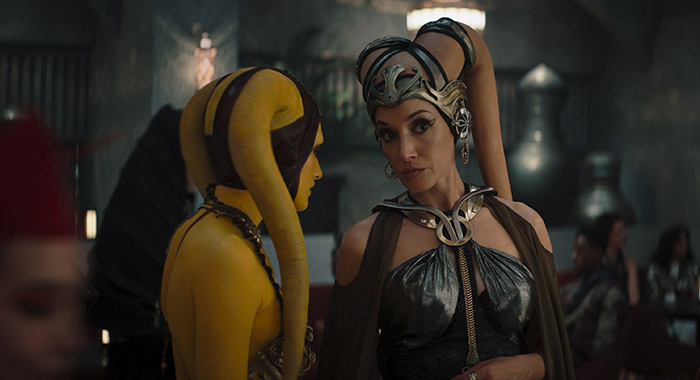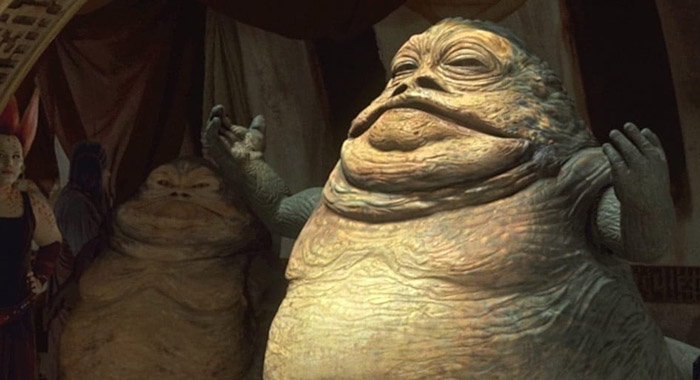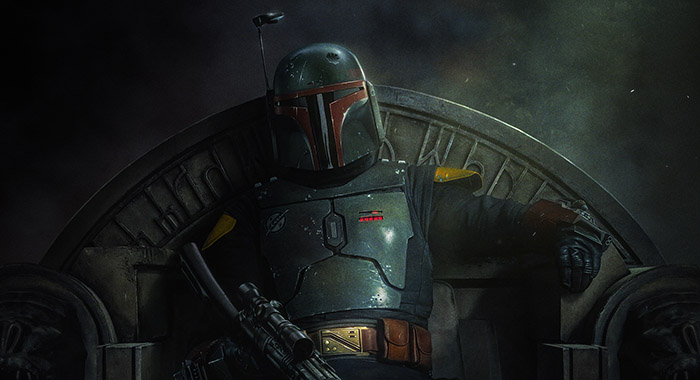TAGGED AS: Disney, Disney Plus, Lucasfilm, streaming, television, TV

(Photo by Disney+/Lucasfilm Ltd.)
A year after its announcement – and decades after fans began to crave it – The Book of Boba Fett is finally opened. But instead of bombast, its first chapter, “Stranger in a Strange Land,” sees Fett (Temuera Morrison) navigating two societies on Tatooine in connected tales set five years apart, which offers writer Jon Favreau and director Robert Rodriguez another chance to explore barely glimpsed corners of the Star Wars galaxy.
Meanwhile, Fett’s motivation in taking over Jabba the Hutt’s criminal empire remains a mystery, but the first 38 minutes of the series may offer a few clues to his overall plan. So let’s dive into the sands of Tatooine for a look at The Book of Boba Fett.
Spoiler Alert: The following reveals details about Chapter 1, “Stranger in a Strange Land,” of The Book of Boba Fett season 1. Stop reading if you have not watched the episode.
Clearly, Jabba the Hutt and Bib Fortuna kept a nice stash of equipment in their palace, including a healing bacta tank ready to repair Fett’s damaged skin. In one way, it serves a production reality – making up Morrison in the more scarred make-up he wore in The Mandalorian would not be advantageous to the actor or the schedule – but it also speaks to the vanity Boba inherited from his father, Jango (also Morrison). As seen in Star Wars: Episode II – Attack of the Clones he asked the cloners of Kamino for one unaltered clone to raise as his son. While in the bacta tank, we get the briefest flashback to Kamino and Boba as a child (Daniel Logan) from that film, which may leave some wondering if, perhaps, surviving clones will factor into Fett’s book.
But to return to the bacta tank, it is clear Fett’s injuries are more than skin deep as he needs the aid of the Gamorean bodyguards to get back to it after the assassination attempt in Mos Espa. Some of those injuries may be explained away in the episode’s extended flashbacks.
Clearly, Fett was already in bad shape when he awoke in the stomach of the Sarlacc and, as we saw in this episode, escaped from what C-3PO called “a new definition of pain and suffering” within its innards. Nevertheless, the struggle to escape the creature’s digestive process left him vulnerable to Jawas, who stole his armor, and Tuskens, who took him prisoner.
Tusken society is one of those barely-glimpsed sectors of the galaxy Favreau and his collaborators love to investigate. From the original Star Wars and Attack of the Clones, we know they attack humanoid settlements. As Din Djarin (Pedro Pascal) notes in The Mandalorian, they are native to the planet and view other humanoids as invading species. What they exactly do to those invaders has always been up for debate, but from what we see here, it is a combination of using captured peoples for sport and slave labor.
Despite that brutality, though, Favreau and Rodriguez suggest some nobility among them. They live a harsh nomadic life on the Tatooine sands, where water is extremely scarce and any notion of a permanent settlement is laughable. Nevertheless, there is artistry in the design of their tents and, as seen here, the individual ornamentation of their clothing. Even in The Mandalorian, the Tuskens still wore the beige uniform look originally created for Star Wars in the late 1970s, but here, a notion of individuality finally starts to appear. We imagine Tusken individuality will matter if flashbacks to Fett’s time with the tribe continue into the next episode.
But the most interesting detail in the flashback is the way Fett seemingly earns their respect by killing the six-limbed sand creature and protecting the Tusken child. The presumed leader of this Tusken faction offers him water, which (if Dune has taught us anything) is a huge deal even if it appears as a simple gesture on screen. It suggests Tuskens will reconsider the situation of their prisoners despite their cruel reputation.
And, we can’t help but wonder if tales of Fett’s feat on the sands ultimately helped Din Djarin negotiate the truce in The Mandalorian’s second season premiere.

(Photo by Francois Duhamel / Lucasfilm Ltd)
A Tusken tribe is not the only culture Fett must learn to navigate in the episode. For one, he faces the paranoia Jabba enforced in his empire, a dynamic first glimpsed in the awkward tribute scene, with Trandoshan Dokk Strassi (Rodriguez in a cameo) offering a threatening welcome to the new daimyo, an Aqualish don presenting a seemingly more genuine offering, and the Mayor of Mos Espa’s majordomo (David Pasquesi) declaring the clearest opposition to Fett’s rule thus far.
Mos Espa (first introduced in Star Wars: Episode I – The Phantom Menace) appears to have prospered in the decades since Anakin Skywalker won the Boonta Eve Classic and, possibly, thrived exponentially since his daughter ended Jabba. It is equally possible, though, that Bib Fortuna maintained Jabba’s holdings with little change in policy. Indeed, everyone from Fennec Shand (Ming-Na Wen) to administrative droid 8D8 are surprised by Fett’s plan to use respect instead of fear and torture in his stewardship of the syndicate.

(Photo by Lucasfilm Ltd.)
And though Sanctuary proprietor Garsa Fwip (Jennifer Beals) welcomes Fett and Shand with warmth and money, Mos Espa almost immediately sicks its fangs on the duo.
The assassination attempt is interesting as it reveals Fett is not as healed as The Mandalorian led us to believe, but it also introduces a nice little mystery: Who ordered the hit? The tribute scene offers a list of suspects – with the Mayor being the most obvious – but we’re inclined to consider one other, off-world option.
Dokk Strassi’s use of the word “daimyo” changes the perception of Jabba’s syndicate ever so slightly. The term, originating in Japan, refers to feudal lords who were themselves under the rule of the Shogun. The relative power of the Shogun and his daimyos waxed and waned across 900 years of Japanense history, but the notion of Jabba (and Fett) as a vassal lord is something we can’t ignore. Fett accepts the wording without question, which suggests to us he knows there is still someone above him. Our guess: the Hutt Cartel on Nal Hutta.

(Photo by Lucasfilm/Walt Disney Studios Motion Pictures)
Old and powerful, the Hutt crime families have ruled over illegal enterprises from their homeworld for millennia. They survived in the face of galactic conflicts, total war between the Jedi and the Sith, and even the Empire itself. Jabba was a member of the cartel’s grand council (according to some sources anyway) and it’s pretty easy to imagine they will be quite angry if Fett rocks the starship with some humanitarian reforms.
Also, it should be noted that Jabba ruled the Outer Rim crime syndicates for centuries. Any disruption of the business, even well-meaning ones, will not be tolerated by stakeholders above and below the daimyo.
Perhaps that’s the real external conflict of The Book of Boba Fett. As glimpsed in the flashback, Fett is not a fan of abject cruelty. Or, at least, his response to seeing a human farmstead raided by gangsters suggests it is against his famous moral code. Combined with his stated aim, it is possible the story concerns just how much cruelty is necessary to keep organized crime viable. And considering cartels like the Hutts outlived the Old Republic and the Empire, Fett may finally be outmatched.

(Photo by Lucasfilm Ltd.)
We are assuming, of course, that Fett’s main motivation is to conduct crime more honorably, but does another concern have him stepping into the role of a daimyo? Simple greed is possible. The galaxy is no safe place for an aging bounty hunter, after all. Then again, taking on the syndicates and cartels isn’t really a way to build a retirement fund, either. There is also another possibility that is both altruistic and self-serving: He plans to use the ill-gotten gains to fund the liberation of Mandalore.
The fate of the planet is something first hinted at in the second season of The Mandalorian. Fett says it was turned to glass by the Empire. But Bo-Katan Kryze (Katee Sackhoff) still intends to rule it as its unquestioned monarch. Well, once she removed an Imperial Remnant occupation. That sort of endeavor is going to cost a lot of money and, as it happens, Fett has a reason to help the cause: legitimacy.
Going back to the earliest days of the Expanded Universe, Boba Fett’s status as a Mandalorian has always been in question. The initial descriptions of the character referred to him as wearing Mandalorian armor, but not necessarily a Mando himself. In some accounts, he is another person altogether who adopted the Fett identity. In the current cannon, his father was a foundling who later received the armor as a gift and may actually be recognized by some of the clans. But due to Boba’s cloned origins, he is not seen as a Mando by people like Kryze. And although tensions between them remained high throughout The Mandalorian’s second season, would her recognition of his status as a Mando (and, perhaps, clarification about his father’s legitimacy) be enough of a boon to fund her dream of liberation?
One other thing to consider: The Fett armor is made of durasteel with some Beskar components. Would recognition offer Boba new armor made predominantly of Beskar? Would he even want that?
As always, mysteries surrounds Boba Fett. But after decades of wondering about his fate at the Pit of Carkoon, we’re glad to ask new questions about this singular character.
![]() 66%
The Book of Boba Fett: Season 1
(2021)
new episodes stream on Wednesdays on Disney+.
66%
The Book of Boba Fett: Season 1
(2021)
new episodes stream on Wednesdays on Disney+.